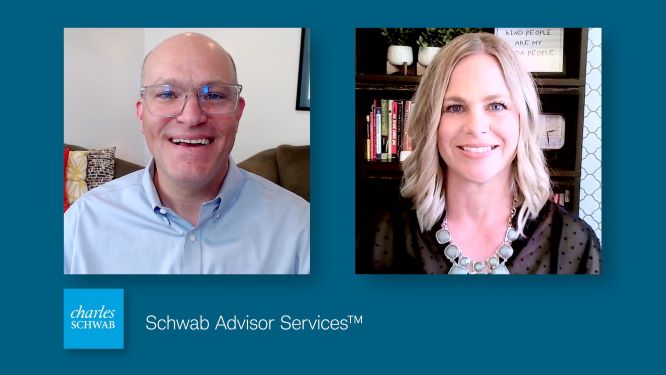Independent Perspectives: New views of the RIA model
Choosing to gain freedom
TRANSCRIPT:
CHRIS REEDY: Hello, I'm Chris Reedy from Schwab Advisor Services. I'm joined by Marcy Shipman, a senior business startup consultant here. Marcy, you've consulted with a number of advisors, who are considering breaking away from their current model, either a wirehouse, regional or IBD, and moving to the independent RIA channel. I imagine a lot of those advisors feel a little overwhelmed and sort of were asking, "What do I do next?"
MARCY SHIPMAN: Yeah, I often ask advisors, really, what are their top concerns when considering launching into the RIA space? I, of course, get a variety of answers, but there's a few common responses I hear. They include concerns about doing the right thing for the client, concerns about the transitioning of the assets and the support they'll receive, and even concerns around compliance because they've had it provided for them in their current environment. But most commonly, I really hear advisors say, "I just don't know what I don't know." They tell me they need help in making sure no pieces go left unchecked, and that, ultimately, nothing falls through the cracks.
CHRIS: So you said they don't know what they don't know, but they must know something about what they're wanting to achieve. What are some of those motivations driving them to speak you?
MARCY: Yeah, the number one thing I hear from advisors is they really feel like flexibility and autonomy in the RIA space provides… will allow them to provide a better experience for their clients. In fact, according to our most recent independent advisor sophomore study, 94% of the advisors reported that they chose the RIA model to really gain the freedom to ultimately do what's best for their client.
Advisors also like the idea of having more control over the choices made and budget spend, especially when it comes to technology.
Advisors have often also heard that RIA firms benefit from increased earning potential. So we actually have the ability to run a model for those advisors, comparing maybe what their potential revenue looks like in the RIA space to what they're currently experiencing in the wirehouse or the IBD model.
CHRIS: I heard one of your colleagues say once that they had advisors tell them it feels like putting together a puzzle without having the picture on the box in front. How do you help them build out that picture? Is it process?
MARCY: Yes. Advisors often have that vision in their head of really what they'd like to create but maybe just can't figure out how to put the pieces together to meet that vision or haven't even taken the time to really figure out the pieces, so that's where our team comes into play. As you said, we provide a process. We call it firm design, and it gives advisors that clarity and that confidence to build their vision. We talk about who is their client, and based on that, what services and experience would be needed. We like to talk about office space, staffing, marketing, really any pieces of the puzzle to help them create that vision. Throughout this process, we also share with them information from our annual Benchmarking Study to, ultimately, help them better understand what other RIAs are doing. And then at the end, we really want to lay out those clear next steps to help them realize that vision and ultimately make sure that no pieces go missing.
CHRIS: As they go through that process, I would imagine a lot of their concern is around the client experience.
MARCY: Absolutely. They've, typically, been very limited in their current environment on how they support their clients, maybe more specifically, how they charge this clients for those services. Advisors are hearing more and more about the experiences that maybe family offices offer, or they're hearing from their clients about additional services that they're interested in. Many advisors just aren't fully aware, unfortunately, of the additional freedom that they can gain in the RIA space. So we really like to spend time talking with advisors about what additional pieces might make sense to add for their ideal client base, and then, ultimately, how they might charge the clients for those additional offerings. Technology is another area advisors like to spend a lot of time on. As you know, Chris, there's just so many options out there for them, so really learning more about which solutions are best for them and for their clients is really important.
CHRIS: So it really sounds like your role is to help advisors imagine the employee and client experience they would like to have and plot a course to make that happen.
MARCY: That's exactly right. We really want to be that thought partner for advisors. Our goal is to, ultimately, provide that clarity and that confidence to help them make the right decisions for both their clients, and, really, for the future success of their firm.
CHRIS: Well, thank you, Marcy. If you're an advisor who would like to learn more about the independent RIA channel, please visit advisorservices.schwab.com.
IMPORTANT INFORMATION:
Information included in this video is intended to be an overview and is subject to change.
The comments, views, and opinions expressed in the presentation are those of the speakers and do not necessarily represent the views of Charles Schwab.
Schwab does not provide legal, regulatory, tax or compliance advice. Consult professionals in these fields to address your specific circumstances.
Schwab Advisor Services' provides custody, trading, and the support services of Charles Schwab & Co., Inc. ("Schwab"), member SIPC, to independent investment advisors and Charles Schwab Investment Management, Inc. ("CSIM"). Independent investment advisors are not owned by, affiliated with, or supervised by Schwab.
©2024 Charles Schwab & Co., Inc. ("Schwab"). All rights reserved. Member SIPC. (0324-MUTV)


